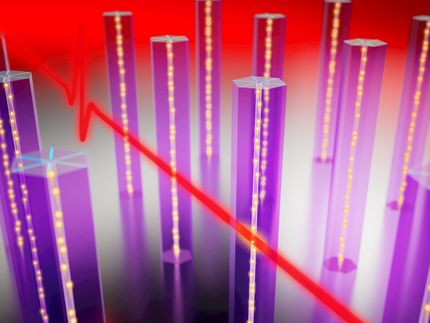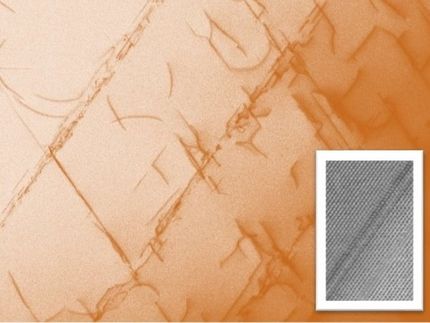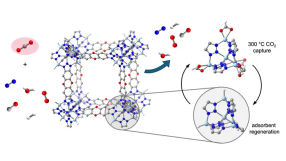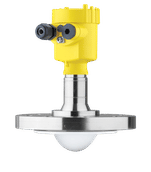Secret of the crystal's corners
New nanowire structure has potential to increase semiconductor applications
New research led by University of Cincinnati physics professors Howard Jackson and Leigh Smith could contribute to better ways of harnessing solar energy, more effective air quality sensors or even stronger security measures against biological weapons such as anthrax. And it all starts with something that’s 1,000 times thinner than the typical human hair – a semiconductor nanowire.
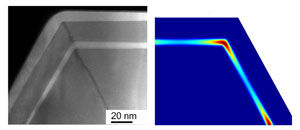
These cross-sectional electron microscope images show a quantum well tube nanowire’s hexagonal facets and crystal quality (left), and electron concentration in its corners.
University of Cincinnati/Howard Jackson
UC’s Jackson, Smith, recently graduated PhD student Melodie Fickenscher and physics doctoral student Teng Shi, as well as several colleagues from across the US and around the world recently have published the research paper “Optical, Structural and Numerical Investigations of GaAs/AlGaAs Core-Multishell Nanowire Quantum Well Tubes” in Nano Letters, a journal on nanoscience and nanotechnology published by the American Chemical Society. In the paper, the team reports that they’ve discovered a new structure in a semiconductor nanowire with unique properties.
“This kind of structure in the gallium arsenide/aluminum gallium arsenide system had not been achieved before,” Jackson says. “It’s new in terms of where you find the electrons and holes, and spatially it’s a new structure.”
Eyes on size cornering electrons
These little structures could have a big effect on a variety of technologies. Semiconductors are at the center of modern electronics. Computers, TVs and cellphones have them. They’re made from the crystalline form of elements that have scientifically beneficial electrical conductivity properties. Many semiconductors are made of silicon, but in this case they are made of gallium arsenide. And while widespread use of these thin nanowires in new devices might still be around the corner, the key to making that outcome a reality in the coming years is what’s in the corner.
These cross-sectional electron microscope images show a quantum well tube nanowire’s hexagonal facets and crystal quality (left), and electron concentration in its corners.
By using a thin shell called a quantum well tube and growing it – to about 4 nanometers thick – around the nanowire core, the researchers found electrons within the nanowire were distributed in an unusual way in relation to the facets of the hexagonal tube. A close look at the corners of the tube’s facets revealed something unexpected – a high concentration of ground state electrons and holes.
“Having the faceting really matters. It changes the ballgame,” Jackson says. “Adjusting the quantum well tube width allows you to control the energy – which would have been expected – but in addition we have found that there’s a highly localized ground state at the corners which then can give rise to true quantum nanowires.”
The nanowires the team uses for its research are grown at the Australian National University in Canberra, Australia – one partner in this project that extends to disparate parts of the globe.
Affecting the scinece of small in a big way
The team’s discovery opens a new door to further study of the fundamental physics of semiconductor nanowires. As for leading to advances in technology such as photovoltaic cells, Jackson says it’s too soon to tell because quantum nanowires are just now being explored. But in a world where hundreds of dollars’ worth of technology is packed into a 5-by-2.5 inch iPhone, it’s not hard to see how small but powerful science comes at a premium.
The team at UC is one of only about a half dozen in the US conducting competitive research in the field. It’s a relatively young discipline, too, Jackson says, and one that’s moving fast. For such innovative science, he says it’s important to have a collaborative effort. The team includes scientists from research centers in the Midwest, the West Coast and all the way Down Under: UC, Miami University of Ohio and Sandia National Laboratories in California here in the US; and Monash University and the Australian National University in Australia.
The team’s efforts are another example of how UC not only stands out as a leader in top-notch science, but also in shaping the future of the discipline by providing its students with high-quality educational and research opportunities.
“We’re training students in state-of-the-art techniques on state-of-the-art materials doing state-of-the-art physics,” Jackson says. “Upon completing their education here, they’re positioned to go out and make contributions of their own.”
Other news from the department science
These products might interest you
Most read news
More news from our other portals
See the theme worlds for related content
Topic world Sensor technology
Sensor technology has revolutionized the chemical industry by providing accurate, timely and reliable data across a wide range of processes. From monitoring critical parameters in production lines to early detection of potential malfunctions or hazards, sensors are the silent sentinels that ensure quality, efficiency and safety.

Topic world Sensor technology
Sensor technology has revolutionized the chemical industry by providing accurate, timely and reliable data across a wide range of processes. From monitoring critical parameters in production lines to early detection of potential malfunctions or hazards, sensors are the silent sentinels that ensure quality, efficiency and safety.
